|

The Carver County Water Management Organization is beginning an annual bulletin to update residents on the health and water quality of Lake Bavaria. This bulletin will be sent out every summer. If you would also like to receive our monthly newsletter for more frequent updates on our projects and programs, or, if you would like to unsubscribe from our newsletters, please visit: www.carvercountymn.gov/government/e-notifications. We appreciate your interest and dedication to keeping our local lakes healthy!
|
|
Water Quality Updates
Lake Bavaria received a C grade for water quality in 2022, which means the lake has average water quality with some algae blooms that may make recreation undesirable early and late in the season. Residents and staff have noticed a decrease in Lake Bavaria's water quality over the past few years, which is likely due to increased development around the lake.
The graph shows water quality results from 2022 for phosphorus and chlorophyll-a concentrations, and transparency measurements. The dashed lines indicate the water quality standards set by the state. Values higher than the standards for phosphorus, chlorophyll-a, or transparency indicate poorer water quality conditions. Lakes are listed as impaired when the average summer values for a given water quality metric are higher than the standard.
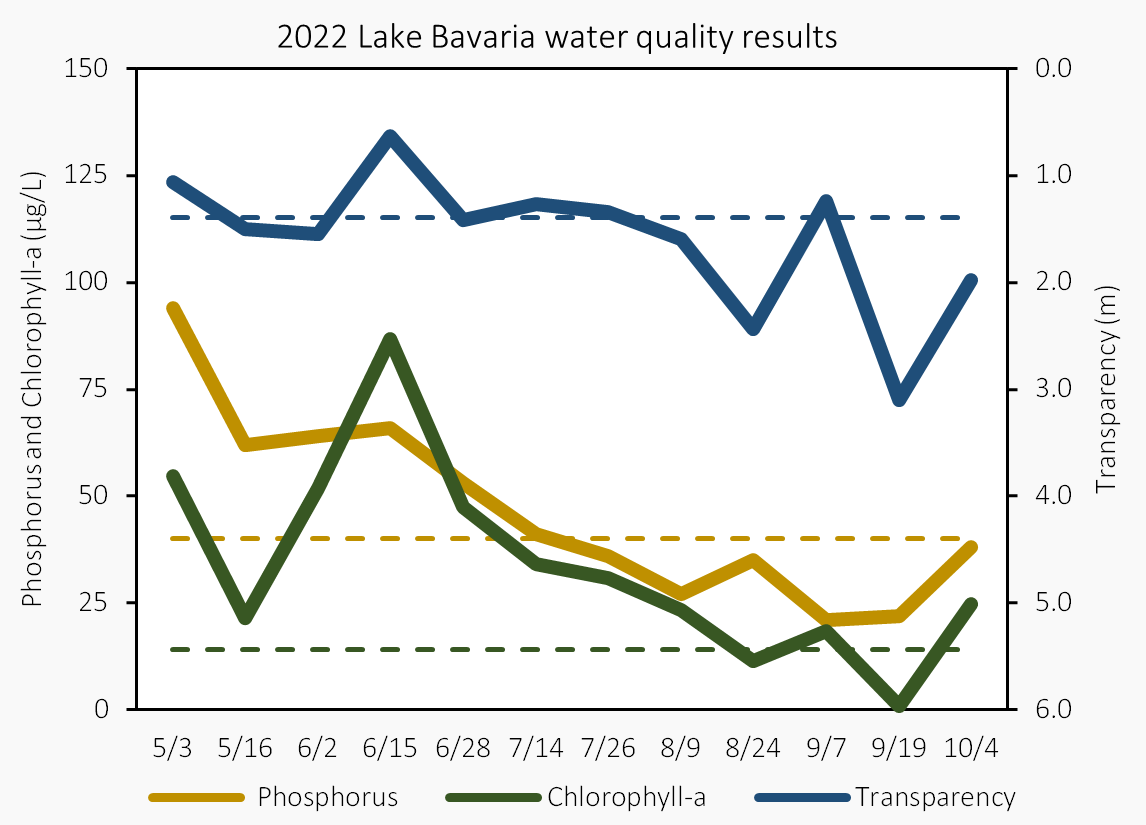 Lake Bavaria water quality results from 2022. The phosphorus (yellow) and chlorophyll-a (green) axis is on the left side of the graph, and the transparency (blue) axis is inverted and on the right side of the graph. We want to see each water quality metric line remain below the dashed standard lines for the best lake health.
|
|
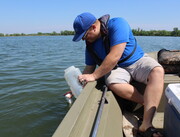 Phosphorus
This nutrient is necessary for lake health, but in high concentrations it can cause algae blooms. Phosphorus levels were high in spring and early summer, but met the water quality standard of 40 µg/L by mid-July. Lake Bavaria was impaired for phosphorus in 2022 with a summer average of 40.6 µg/L.
|
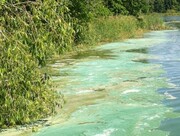 Chlorophyll-a
This compound is produced in plants and is a measurement of how much algae is in the lake. Chlorophyll-a concentrations spiked in mid-June, but met the water quality standard of 14 µg/L by mid-July. Lake Bavaria was impaired for chlorophyll-a in 2022 with a summer average of 33.9 µg/L.
|
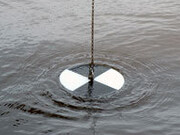 Transparency
We measure transparency using Secchi disks. The deeper into the water the disk is still visible, the greater the water transparency value. Water transparency was fairly consistent throughout the year, with a few measurements that did not meet the visibility standard of 1.4 m. Lake Bavaria was not impaired for transparency in 2022 with a summer average of 1.6 m.
|
|
Historic drought
The drought in 2021 was the worst in Minnesota since 1988. This drought continued into 2022 and caused water levels to recede to near historic lows. Record amounts of snow this past winter improved drought conditions in the spring, but now much of Carver County and the state are again experiencing abnormally dry conditions. We will continue to track impacts of this prolonged drought as we monitor our aquatic ecosystems this year.
Although droughts often have negative impacts on aquatic ecosystems, the 2021-2022 drought improved water clarity on Lake Bavaria, because fewer pollutants flowed into the lake with stormwater runoff as there was less rain.
|
|
The water level on Lake Bavaria reached its lowest level since 1998 during the drought, exposing much of the shoreline.
|
|
Fish Survey
Minnesota Department of Natural Resources technicians performed a fish survey on Lake Bavaria in the spring and summer of 2022. They found healthy populations of many fish species, including largemouth bass, bluegill, black crappie, and northern pike. However, DNR staff determined that stressors on the lake, such as shoreline development, nutrient pollution, and aquatic invasive species, were negatively impacting the fish community. We can help keep Lake Bavaria's fish community healthy by working together to improve water quality on the lake!
|
|
What can you do to keep Lake Bavaria healthy?
The ways we live on and around lakes have large impacts on water quality. Check out this video from the Anoka County Soil and Water Conservation District to see how we impact lake health, and what we can do to ensure we are good stewards of our water.
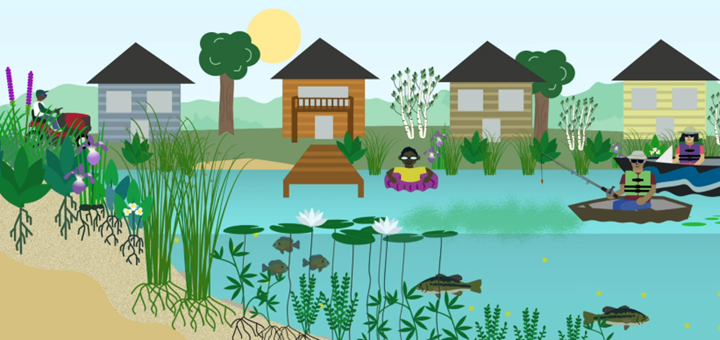
|
|
Victoria Pond Retrofit
In 2020, new filter benches were added to a stormwater pond on the west side of Victoria Dr. (Co. Rd. 11) that drains to Lake Bavaria. The filter benches are strips of sand mixed with iron shavings on the sides of the pond. When water filters through the sand and iron, phosphorus binds to the iron and is removed from the water. This helps reduce the amount of phosphorus that flows into Lake Bavaria in stormwater, which improves water quality.
|
|
The sand iron filters, marked by the green risers, were installed on either side of the pond inlet.
|
|
Score-Your-Shore Evaluation
In 2019, staff evaluated the health of shoreline habitats on 57 developed lots around Lake Bavaria using the Department of Natural Resource's Score-Your-Shore evaluation criteria. The score was based on the amount of trees, shrubs, and groundcover on the land around the lake, as well as the amount of aquatic vegetation and woody habitat in the water on each lot. The average scores for the terrestrial and aquatic shoreline evaluations were 57 out of 100 points, which indicates many areas around the lake are highly developed with little native vegetation. Restoring shorelines to their natural state using native terrestrial and aquatic plants helps protect Lake Bavaria by reducing the amount of stormwater runoff that enters the lake. Natural shorelines also provide vital habitat for animals, such as ducks, fish, frogs, turtles, and beneficial insects.
|
|
The shoreline of Lake Bavaria is the lake's last defense against stormwater runoff pollution.
|
|
|
There are several programs and opportunities for you to help keep our water clean!
|
|
Water Quality Cost-Share Program
The Carver County Water Management Organization wants to help you protect our water! If you have a project you would like to implement that will improve water quality, we can match 75% (up to $5,000) of the cost of your project. These projects include raingardens, shoreline restoration, water reuse projects, and more!
|
|
Pollinator Conservation Program
The Carver County Soil and Water Conservation District has funding to help you install new pollinator gardens! These gardens provide food and shelter to native pollinators and keep our water clean by preventing soil erosion and stopping runoff from reaching lakes and streams. You may receive up to $2,000 to create this beautiful habitat!
|
|
Shoreline Habitat Program
How healthy is your shoreline? Native plants keep runoff out of our lakes and streams better than turf grass. The Carver County Soil and Water Conservation District has funding to convert your turf grass shoreline into native habitat. You may receive 75% (up to $2,500) to establish native shorelines that keep our lakes clean!
|
|
Rachio Smart Sprinkler Discount
The Carver County Water Management Organization has partnered with Rachio to save Chaska residents $80-110 off a new Rachio Smart Sprinkler Controller. These controllers use local weather data to know the best times to water your lawn and garden, saving you money and conserving water.
|
|
Love your aquatic plants, here's why...
Native aquatic plants are key to maintaining high-water quality and promoting lake ecosystem health! Lake Bavaria is home to 17 species of native aquatic plants, including coontail, forked duckweed, northern watermilfoil, and white water lily. These plants have several roles in protecting Lake Bavaria, which we will explore below.
|
|
 |
|
Preventing lake shore erosion
Aquatic plant roots hold soil in place and prevent waves from kicking up sediment. This prevents shoreline erosion and helps keep water clear.
Providing food and shelter to aquatic animals
Plants are the basis of the food web and provide shelter for many animals, which allows Lake Bavaria to support a diverse community of fish, amphibians, insects, and waterfowl.
Filtering water
Aquatic plants remove phosphorus and nitrogen from the water as they grow, which stops algae blooms from developing during the summer.
|
|
|
What if plants interfere with recreation?
It may be unenjoyable to swim and boat in areas of the lake with many aquatic plants. But it is also unenjoyable to recreate on lakes with very poor water quality. In some circumstances, it is against the law to destroy or remove aquatic plants from lakes without a permit from the Minnesota Department of Natural Resources. Always check with the DNR before removing aquatic vegetation and leave as many aquatic plants as possible that do not interfere with recreation.
Invasive aquatic plants
Unfortunately, not all aquatic plants are beneficial for lake health. Invasive aquatic plants can take over lakes and kill native plants. Lake Bavaria currently contains two species of invasive aquatic plants: Eurasian watermilfoil and curlyleaf pondweed. We can prevent the spread of these plants by supporting diverse native aquatic plant communities, which make it harder for invasive plants to establish in a lake. Always make sure to check your boat and fishing equipment for aquatic hitchhikers when moving between lakes to prevent any further spread of invasive species in Carver County.
|
|
|
You can make a big difference in the quality of Lake Bavaria! Please do not hesitate to reach out to us with any questions, comments, or concerns about lake and stream health in Carver County.
|
|
|
|
|